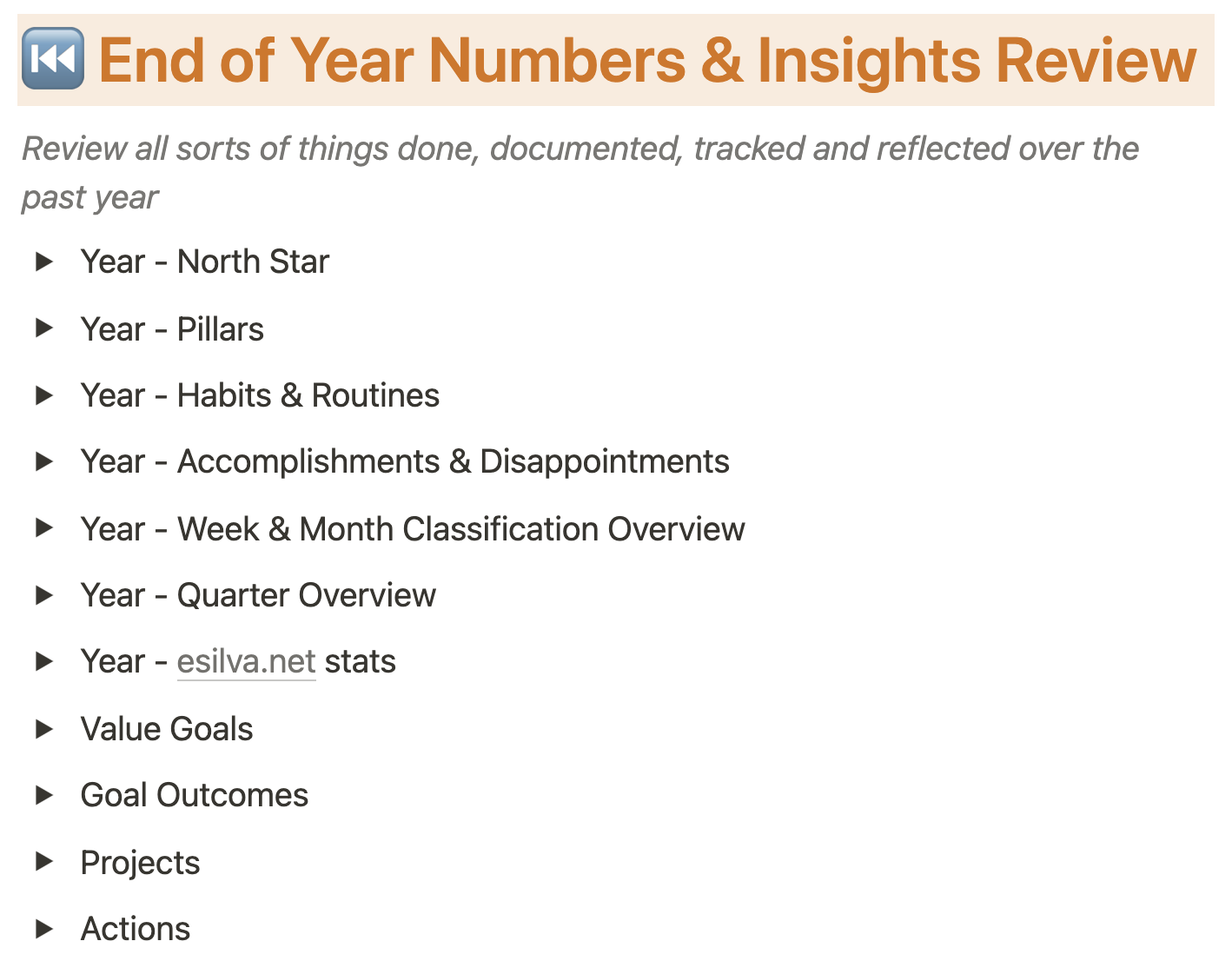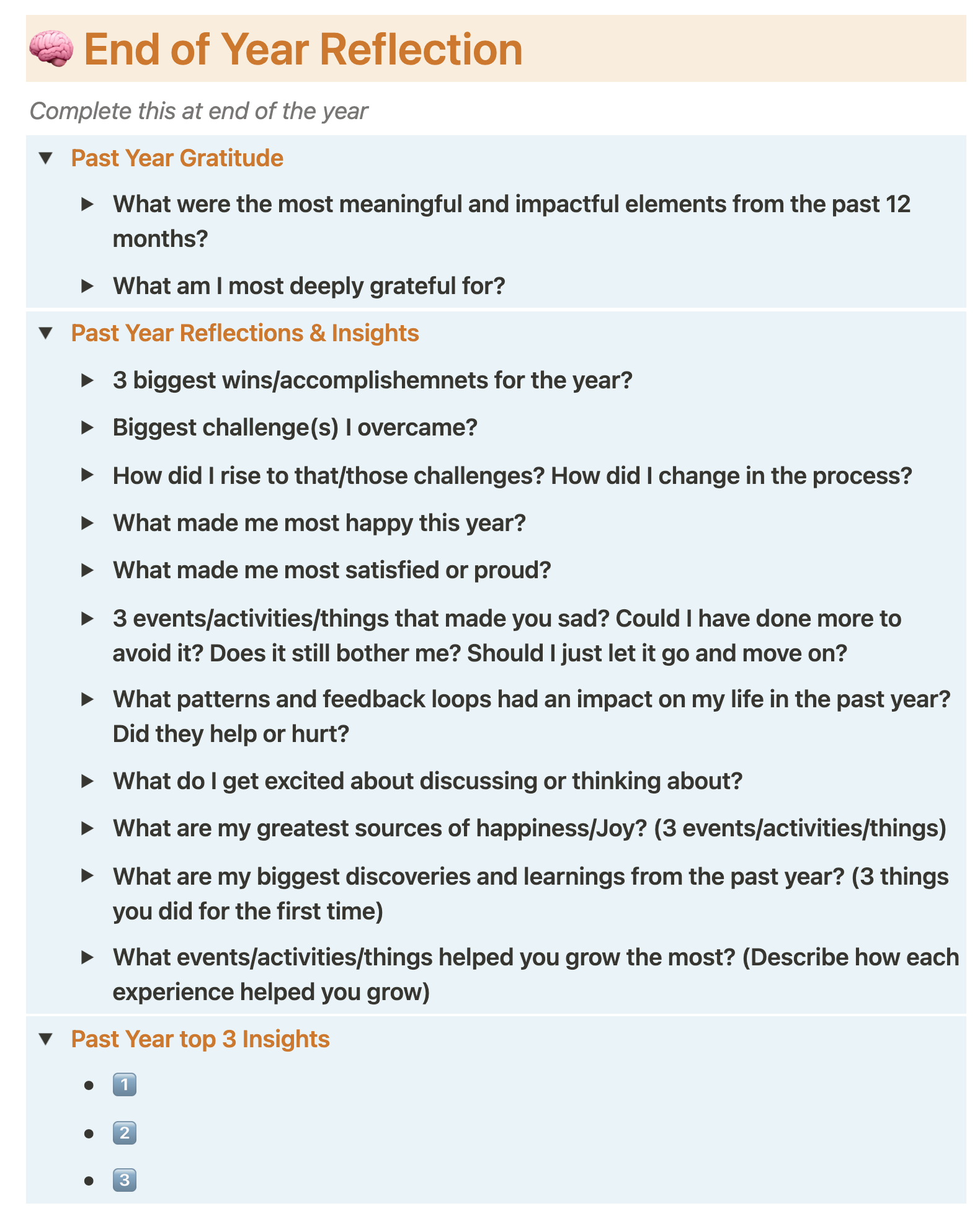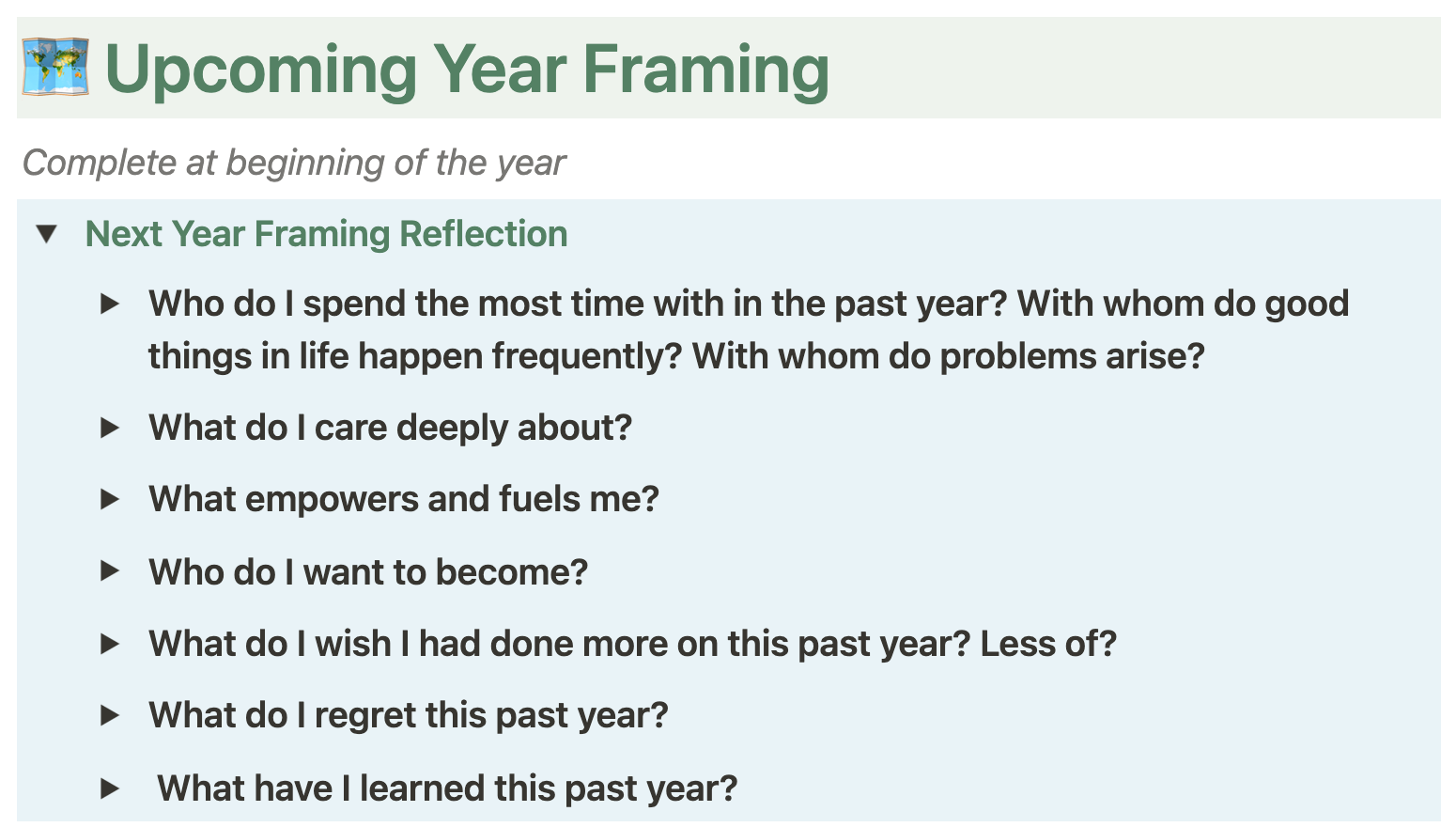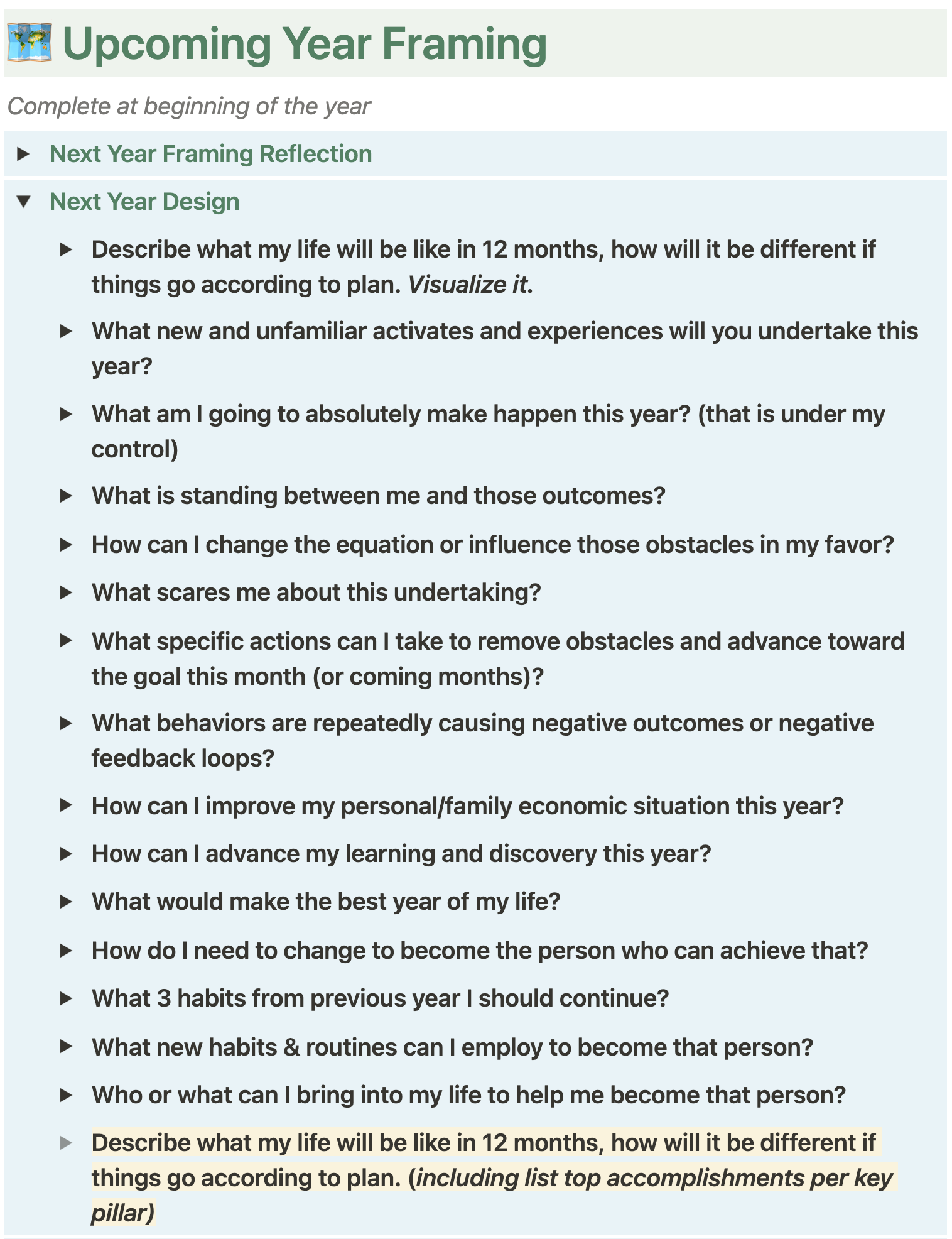End-of-Year Review & Upcoming Year Planning Ritual
TL;DR: This article overviews the reflection and planning ritual I go over at the end of each year. I have been doing this in different forms for many years and find it a great way to "recalibrate my north star" and shape better, more concrete plans for the upcoming year. I do this in two main steps: 1) "look back" and reflect on the year ending (look at what happened, what I learned, what worked and did not work, etc.); 2) "look forward" - based on all the insights and learnings from 1), I visualize and describe the key "aspirations" I want to invest/develop/prioritize in the upcoming year. The last step is ensuring I translate the aspirations defined into actionable things in my system for execution. I set clear outcomes, projects & habits for the upcoming year, enabling me to move toward my aspirations. I review and recalibrate these often on my quarterly and monthly reviews. People overlook this last element, which tends to be a recipe for staying in "dreamland" and never actually getting things happening.
Updated: 20/12/2023
Notes: The elements shared in this article can be used to guide end-of-the-year reflections in any shape and form. I have a system based on the PPV by August Bradley. This system has the notion of “Year” where we can systematically include this Year Review & Planning. Furthermore, this system connects this exercise to all relevant elements of the “Life Operating System” PPV offers, including Projects and other things to get the “aspirations” in motion and the regular reviews and elements that enable us to keep things meaningful and on track. Find my quick overview of PPV in this article. However, these ideas can be implemented in any system - do not get bogged down in the technicalities; focus on reflecting and making things happen!
End-of-Year Recalibration
End-of-year review (and planning for the upcoming year) can be a powerful ritual to zoom out from the busy day-to-day routines and reflect on the year’s ending. This “recalibration” ritual enables us to learn from the many things we did over the past year and whether those are helping us move forward or not (also, “what moving forward” actually means - in my view, that is too continuously changing and evolving). This reflection provides an excellent framework for visualizing and shaping the upcoming year.
I have been doing this exercise for a few years now, and it gives me a lot of energy to close the year by looking at all the things I learned (good and bad) over the past year. This reflection also enables planning for the upcoming year with a clearer framing of the crucial things one wants to focus on. That allows shaping more specific actions for execution and moving towards one’s aspirations. This last part is vital: people are good at reflecting and dreaming. However, those are useless if we are not good at defining clear and actionable outcomes and projects to move towards those aspirations.
Review & Planning
The figure below provides a high-level overview of my ritual. In the following sections, I give some details on the two main parts of this ritual: 1) Year Ending Review and 2) Upcoming Year Planning, and the multiple steps in each part (which I highly advise following in the sequence described so that you incrementally build up the reflection).
Notes: I will share some snippets of my “template” as I describe the different steps. I usually do my “Year Ending Review” at the end of the year and then create a new Year entry on my system, where I fill in the “Upcoming Year Planning” parts.

1: Year-Ending Review
1.1: Review numbers and insights
The first thing I do when starting my “Year Ending Review” is review what I did over the past year. This review can entail many different things, for example:
- objectives set in the previous year (and target outcomes. I tend to look at those on the three central pillars of my life: 1) Work & Career; 2) Home & Family; 3) Personal & Growth);
- projects I worked on (and outcomes);
- things I learned (try to list all things here);
- reviews & statistics (e.g., if you do weekly reviews and track your “week score”, you can look at them. The same is true for monthly and quarterly reviews. It is interesting to look at summaries and “refresh” your mind with those elements);
- etc.
Here you can find a screenshot of the types of things I look into in this step.

💡The goal here is: refresh your mind with important things that happened over the past year and how it went in general. I also like to get some numbers down, e.g., how many articles did I publish on my blog, how were my “week scores”, etc.). I do write some notes and “insights” per each element I look into (it becomes a sort of documentation - but also helps me to set those ideas in my mind further, which I find essential to better approach the next steps of the ritual).
1.2: Perform End-of-Year Reflection
After reviewing the numbers and insights of the past year, we have a much fresher and clearer mindset to approach the next step of the ritual: perform the actual End-of-Year reflection.
I answer several questions that enable me to reflect deeply on the year ending. The following image shows my current template (highly influenced by templates and questions from several people).

It is a rather long list of questions. Some may make little sense to some people. However, they provide an excellent framing for a deep reflection. Don’t overthink your answers; go with the things that come to mind when answering these questions (they are aimed at reflecting on the insights from the previous step).
💡The goal here is: reflect on things we are grateful for in the year ending; accomplishments and challenges; things that made us happy and sad; things that we got excited about; things that brought happiness and joy; things we learned; and finally what has helped us to grow the most. Doing this should enable a deeper reflection on the year that is ending.
2: Upcoming Year Planning
2.1: Framing Reflection
In 1.2, we reviewed the previous year, which allows us to clarify the most important things happening at the year’s end. This creates a great starting point to approach the upcoming year’s planning.
I use the word “planning” to “ reflect and shape” the important topics and things I want to focus on in the upcoming year. It is not about creating a “rigid” step-by-step plan. This plan should (and will) be changed and improved as we move forward, do things and learn. We will be “re-adjusting” this plan regularly. However, it is vital that we explicitly think about it using all sorts of learnings and insights to make it as straightforward and actionable as we can.
The first step in this is the “New Year Framing Reflection”. Below, you can find the questions I use to approach this step.

💡The goal here is: reflect on essential elements in one’s life, namely: people with whom I worked and spend time, things I care about, who I want to become, things I can improve on, things I regret doing; and what I learned from last year. These are great framing questions to go over to start “designing” the upcoming year.
2.2: Upcoming Year Design
This step focuses on “designing the upcoming year” (from all the framing done in the previous sections).
It should take some hours to complete. In my view, we should not rush, as this is the most important step of the whole ritual. This part allows us to consolidate all things into explicit aspirations that provide a clear direction for moving forward. The exercise here is about re-assessing and adjusting aspirations for the upcoming year. That should enable shaping concrete and measurable outcomes to drive actionable projects towards those aspirations.
These are the questions I ask myself in this step.

As you can see, the questions build on each other, so it is essential to answer them sequentially. Again, do not overthink; answer the questions with the things in your mind. They tend to be the most “important things” and will be the outcome of the reflections on the previous steps.
💡The goal here is: look forward, visualize, and describe essential things to consider on the different vital pillars. Through these questions, one starts visualizing what matters and should be considered and worked on/developed in the upcoming year. This step culminates in the question: “describe what my life will be like in 12 months”. In this question, we can describe as clearly as possible those “aspirations”, including defining accomplishments (outcomes) we should have achieved if things go according to plan.
2.3: Set System Implementation
The final step of this ritual focuses on translating the reflections and aspirations of the previous step (especially the “description of my life in 12 months”) into tangible and actionable outcomes. These can drive concrete projects and habits in the upcoming year.
As part of this exercise, ensure those elements are explicit on your “system for execution”. This can be whatever tool and method you use (digital or analog). It is essential to ensure it is not just an “aspiration” but becomes actionable to enable actual progress. Below is an overview of what I go over on my system (I will share some details and a link to the template in the next section).

On my system, I go over the following main parts:
- Start by updating the more “long-term aspirational” elements, such as my “North Star”, which describes my long-term ambitions for all my key pillars. This is somewhat aspirational and longer-term, and I do not limit myself to “how” and “when” questions;
- Then I go into shaping aspirations I will focus on this upcoming year: these are the key targets and outcomes for the upcoming year that allow me to move towards my “North Star”. You can think of these as top “Objective and Key Results” (OKRs) for the year. I aim to define the “Top-3” Objectives per core pillar (Work, Family and Personal). These represent the important things for me and my aspirations for the upcoming year.
- Then, I define concrete results/outcomes I want to achieve in the coming year per Objective. These are concrete and allow me to have targets and measure my progress. They also provide the essential elements for planning my Quarters (and then Months).
- After defining that year’s Objectives and Target Outcomes, I plan the Quarters. In particular, I focus on preparing the first quarter of the year to get things started and moving. I plan little afterwards, as things are unclear and may change. However, I want to start getting clarity on my next steps (and then I will review and update some of the things on my Year Objectives and Target Outcomes as I progress over the year).
- Finally, set the projects in motion to enable progress. These should contribute to the objectives and target outcomes I have defined for the year and quarter. This is key to ensuring we focus on the most important things.
💡The goal here is: make sure we translate the aspirational framing into very actionable things. That should trigger execution (and learning) on what we deem important. We do not want to make this a “day-by-day planning” for the whole year (that never works). However, we want to set things in motion for the coming days, weeks, and months with projects (and/or habits) that enable us to move forward. As we progress in the year, we should revisit these elements and adjust them (especially “Target Outcomes” and “Projects”). An effective way to do this is to have regular review moments (e.g., weekly, monthly, and quarterly reviews - where one can revisit these elements and update them with all the learnings one has to enable better execution).
Final Remarks
Some final remarks to consider when performing and implementing this ritual:
- Approach this ritual with the flow/sequence described in the article. The different sections build on each other, and doing the reflections with the suggested flow should lead to good outcomes.
- You can find the complete template I refer to in the previous section here: End of Year Review Template - Notion or End of Year Review Template - Google Docs. The Notion template is part of my Life Operating System (Life OS) setup. My Life OS implementation is highly inspired by the PPV Life OS method developed by August Bradley (who has also shared his template and instructions for his end-of-year ritual here). However, the template - its flow and questions - can be equally valuable for any other setup (e.g., simply reflecting on the year ending and visualizing and planning for the upcoming year, including clear projects to work on).
- One last time: ensure you do not stop on the visualization and aspirations. It is vital that you define clear and actionable things to execute and move forward. To make this effective, do regular reviews and “recalibrations” (we are constantly learning and, with more insights, can better prioritize where to spend our time).
- Credits to the many people who influenced this flow and template, namely August Bradley, Patrick Kua, Marie Poulin, among many others.
Conversation
📣 New article “End of Year Review & Upcoming Year Planning Ritual".
— Eduardo da Silva (@emgsilva) December 28, 2021
I share the reflections I go through to recalibrate on the important things and with that set a clear direction for the upcoming year (& initial steps to start moving there).https://t.co/yKX0ExkBrU pic.twitter.com/SOrqbuEGr3